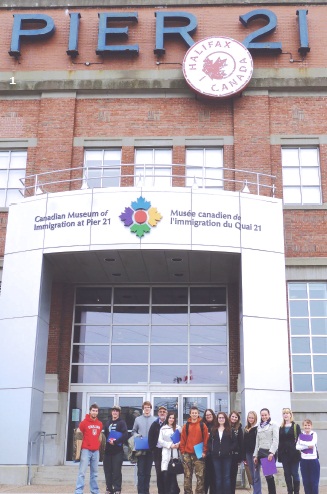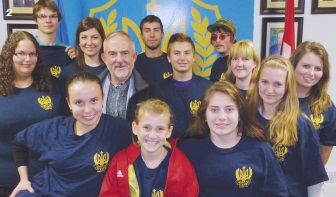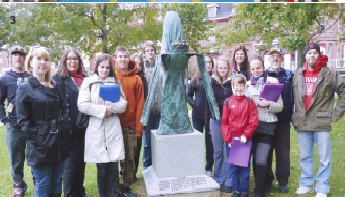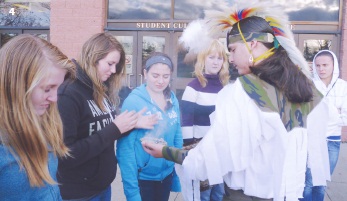Learning
Over Lobster
By
Natalie Witiuk
 On
October 26, 2011, twelve young people from across Canada greeted one
another at Pearson Airport in Toronto for the first time. They were
about to depart on a five-day educational excursion to Nova
Scotia, organized by the Paul Yuzyk Institute for Youth Leadership.
These participants embarked to learn about the Ukrainian experience
at the Canadian Museum of Immigration at Pier 21 in Halifax, Nova
Scotia’s Ukrainian Canadian legacy, intercultural understanding,
and much, much more! Within hours, the group arrived in Lunenburg
where they explored the Fisheries Museum, observed the reconstruction
of the Bluenose II, and tried their hand at fishing. Although some
caught more fish than others, it was clear that every one of the
students would return home with new ideas, informed perspectives and
a renewed commitment to strengthening the Ukrainian organizations
they came from.
On
October 26, 2011, twelve young people from across Canada greeted one
another at Pearson Airport in Toronto for the first time. They were
about to depart on a five-day educational excursion to Nova
Scotia, organized by the Paul Yuzyk Institute for Youth Leadership.
These participants embarked to learn about the Ukrainian experience
at the Canadian Museum of Immigration at Pier 21 in Halifax, Nova
Scotia’s Ukrainian Canadian legacy, intercultural understanding,
and much, much more! Within hours, the group arrived in Lunenburg
where they explored the Fisheries Museum, observed the reconstruction
of the Bluenose II, and tried their hand at fishing. Although some
caught more fish than others, it was clear that every one of the
students would return home with new ideas, informed perspectives and
a renewed commitment to strengthening the Ukrainian organizations
they came from.
The
students shared their stories and backgrounds over freshly caught
lobster (a new experience for most of them), and learned that they
came from 8 different cities: Edmonton, Regina, Saskatoon, St.
Catharines, Toronto, Sudbury, Ottawa and even Kyiv, Ukraine. These
participants were anxious to learn about one another and the roles
they play in the communities and organizations they came from.
 On
the second day of the excursion, sharing and dialogue continued, but
were heavily influenced by the places visited. At the Canadian
Museum of Immigration at Pier 21, the students participated in an
immigration simulation exercise which provided insight into their
ancestors’ immigration experience upon arriving in Canada. After
Pier 21, the focus of the trip shifted towards building leadership
capacity in the Ukrainian community by learning from, and learning
about other cultures or heritage-based communities. The students
participated in a cultural exchange program with the Indian Brook
School - a First Nations school that teaches Mi’kmaq language and
culture to students as part of its curriculum. By experiencing
first-hand how this school has addressed the challenge of educating
young people in the Mi’kmaq community, the visiting students gained
insight into how their own organizations might keep people engaged
and invested in their community. The second day in Halifax concluded
with a community dinner where the students had the opportunity to
connect with members of the Ukrainian-Canadian Association in Halifax
- a small but passionate group of Ukrainian-Canadian families in the
Halifax-Dartmouth area who have found ways to actively celebrate and
promote their heritage despite their limited numbers.
On
the second day of the excursion, sharing and dialogue continued, but
were heavily influenced by the places visited. At the Canadian
Museum of Immigration at Pier 21, the students participated in an
immigration simulation exercise which provided insight into their
ancestors’ immigration experience upon arriving in Canada. After
Pier 21, the focus of the trip shifted towards building leadership
capacity in the Ukrainian community by learning from, and learning
about other cultures or heritage-based communities. The students
participated in a cultural exchange program with the Indian Brook
School - a First Nations school that teaches Mi’kmaq language and
culture to students as part of its curriculum. By experiencing
first-hand how this school has addressed the challenge of educating
young people in the Mi’kmaq community, the visiting students gained
insight into how their own organizations might keep people engaged
and invested in their community. The second day in Halifax concluded
with a community dinner where the students had the opportunity to
connect with members of the Ukrainian-Canadian Association in Halifax
- a small but passionate group of Ukrainian-Canadian families in the
Halifax-Dartmouth area who have found ways to actively celebrate and
promote their heritage despite their limited numbers.
 On
the third day of the excursion, the students visited Peggy’s Cove.
After taking in the beautiful view and the brisk sea breeze, they
were off to Dartmouth to visit the Black Cultural Centre of Nova
Scotia. Dr. Henry Bishop delivered a lively presentation about the
importance of embracing and maintaining different forms of cultural
expression such as language, music and dance. They were captivated
by “Dr. B’s” engaging account of his journey to realize the
importance of his cultural roots. At the end of the trip, many of
the participants shared that it was the visit to the BCC that
inspired them to get more involved in their Ukrainian community at
home. This day ended with a more informal cultural experience - a
ceilidh (traditional Gaelic social gathering) in Blues Mills,
where the students shared their Ukrainian culture with others by
performing traditional Ukrainian songs and dances for the residents
of this rural community.
On
the third day of the excursion, the students visited Peggy’s Cove.
After taking in the beautiful view and the brisk sea breeze, they
were off to Dartmouth to visit the Black Cultural Centre of Nova
Scotia. Dr. Henry Bishop delivered a lively presentation about the
importance of embracing and maintaining different forms of cultural
expression such as language, music and dance. They were captivated
by “Dr. B’s” engaging account of his journey to realize the
importance of his cultural roots. At the end of the trip, many of
the participants shared that it was the visit to the BCC that
inspired them to get more involved in their Ukrainian community at
home. This day ended with a more informal cultural experience - a
ceilidh (traditional Gaelic social gathering) in Blues Mills,
where the students shared their Ukrainian culture with others by
performing traditional Ukrainian songs and dances for the residents
of this rural community.
 The
next day started in Sydney, Nova Scotia. The students visited the
Fortress of Louisbourg, and drew parallels between the expulsion of
the Acadians who inhabited the area and that of the resettled
Ukrainians of “Zakerzonnia” in Poland. In the afternoon, the
participants got a taste of the type of work that Ukrainian
immigrants found when they came to Canada. The students visited the
Glace Bay Miner’s Museum and walked through old mine tunnels with
hard hats and walking sticks to navigate the mine, where in some
areas was barely 4 feet tall! The day concluded with a
cross-cultural seminar at Cape Breton University (CBU) where Dr.
Marcia Ostashewski, along with her colleagues from CBU, discussed
different communities and cultures on Cape Breton, and allowed the
students to actively participate in Gaelic and Mi’kmaq activities
such as a smudge ritual practice.
The
next day started in Sydney, Nova Scotia. The students visited the
Fortress of Louisbourg, and drew parallels between the expulsion of
the Acadians who inhabited the area and that of the resettled
Ukrainians of “Zakerzonnia” in Poland. In the afternoon, the
participants got a taste of the type of work that Ukrainian
immigrants found when they came to Canada. The students visited the
Glace Bay Miner’s Museum and walked through old mine tunnels with
hard hats and walking sticks to navigate the mine, where in some
areas was barely 4 feet tall! The day concluded with a
cross-cultural seminar at Cape Breton University (CBU) where Dr.
Marcia Ostashewski, along with her colleagues from CBU, discussed
different communities and cultures on Cape Breton, and allowed the
students to actively participate in Gaelic and Mi’kmaq activities
such as a smudge ritual practice.
On
the final day of the trip, the students attended Liturgy
at Holy Ghost Ukrainian Catholic Church, and then visited nearby St.
Philip’s African Orthodox parish. The trip ended with a wrap-up
session that pulled together all of the lessons learned through the
different experiences the students had shared over the last 5 days.
They discussed their new insights, and shared ideas about how they’d
like to get more involved in their Ukrainian communities. Most
importantly, they talked about how they could help one another with
initiatives they’d like to see in their communities, and build
strong ties with one another that will last and be remembered for
much longer than their delicious lobster dinner!
PHOTOS
1
– In front of the Canadian Museum of Immigration at Pier 21
2
– All smiles as the group concludes their journey with a wrap-up
session in the Ukrainian Catholic Men’s Club Room at Holy Ghost
Church in Sydney, Nova Scotia
3
– Students visit the “Vitayemo” Immigration Memorial in
Halifax, commemorating 100 years of immigration of Ukrainians to
Canada
4
– Smudge Ritual: Students experience traditional Mi’Kmaq cultural
practices at Cape Breton University
 On
October 26, 2011, twelve young people from across Canada greeted one
another at Pearson Airport in Toronto for the first time. They were
about to depart on a five-day educational excursion to Nova
Scotia, organized by the Paul Yuzyk Institute for Youth Leadership.
These participants embarked to learn about the Ukrainian experience
at the Canadian Museum of Immigration at Pier 21 in Halifax, Nova
Scotia’s Ukrainian Canadian legacy, intercultural understanding,
and much, much more! Within hours, the group arrived in Lunenburg
where they explored the Fisheries Museum, observed the reconstruction
of the Bluenose II, and tried their hand at fishing. Although some
caught more fish than others, it was clear that every one of the
students would return home with new ideas, informed perspectives and
a renewed commitment to strengthening the Ukrainian organizations
they came from.
On
October 26, 2011, twelve young people from across Canada greeted one
another at Pearson Airport in Toronto for the first time. They were
about to depart on a five-day educational excursion to Nova
Scotia, organized by the Paul Yuzyk Institute for Youth Leadership.
These participants embarked to learn about the Ukrainian experience
at the Canadian Museum of Immigration at Pier 21 in Halifax, Nova
Scotia’s Ukrainian Canadian legacy, intercultural understanding,
and much, much more! Within hours, the group arrived in Lunenburg
where they explored the Fisheries Museum, observed the reconstruction
of the Bluenose II, and tried their hand at fishing. Although some
caught more fish than others, it was clear that every one of the
students would return home with new ideas, informed perspectives and
a renewed commitment to strengthening the Ukrainian organizations
they came from. On
the second day of the excursion, sharing and dialogue continued, but
were heavily influenced by the places visited. At the Canadian
Museum of Immigration at Pier 21, the students participated in an
immigration simulation exercise which provided insight into their
ancestors’ immigration experience upon arriving in Canada. After
Pier 21, the focus of the trip shifted towards building leadership
capacity in the Ukrainian community by learning from, and learning
about other cultures or heritage-based communities. The students
participated in a cultural exchange program with the Indian Brook
School - a First Nations school that teaches Mi’kmaq language and
culture to students as part of its curriculum. By experiencing
first-hand how this school has addressed the challenge of educating
young people in the Mi’kmaq community, the visiting students gained
insight into how their own organizations might keep people engaged
and invested in their community. The second day in Halifax concluded
with a community dinner where the students had the opportunity to
connect with members of the Ukrainian-Canadian Association in Halifax
- a small but passionate group of Ukrainian-Canadian families in the
Halifax-Dartmouth area who have found ways to actively celebrate and
promote their heritage despite their limited numbers.
On
the second day of the excursion, sharing and dialogue continued, but
were heavily influenced by the places visited. At the Canadian
Museum of Immigration at Pier 21, the students participated in an
immigration simulation exercise which provided insight into their
ancestors’ immigration experience upon arriving in Canada. After
Pier 21, the focus of the trip shifted towards building leadership
capacity in the Ukrainian community by learning from, and learning
about other cultures or heritage-based communities. The students
participated in a cultural exchange program with the Indian Brook
School - a First Nations school that teaches Mi’kmaq language and
culture to students as part of its curriculum. By experiencing
first-hand how this school has addressed the challenge of educating
young people in the Mi’kmaq community, the visiting students gained
insight into how their own organizations might keep people engaged
and invested in their community. The second day in Halifax concluded
with a community dinner where the students had the opportunity to
connect with members of the Ukrainian-Canadian Association in Halifax
- a small but passionate group of Ukrainian-Canadian families in the
Halifax-Dartmouth area who have found ways to actively celebrate and
promote their heritage despite their limited numbers. On
the third day of the excursion, the students visited Peggy’s Cove.
After taking in the beautiful view and the brisk sea breeze, they
were off to Dartmouth to visit the Black Cultural Centre of Nova
Scotia. Dr. Henry Bishop delivered a lively presentation about the
importance of embracing and maintaining different forms of cultural
expression such as language, music and dance. They were captivated
by “Dr. B’s” engaging account of his journey to realize the
importance of his cultural roots. At the end of the trip, many of
the participants shared that it was the visit to the BCC that
inspired them to get more involved in their Ukrainian community at
home. This day ended with a more informal cultural experience - a
ceilidh (traditional Gaelic social gathering) in Blues Mills,
where the students shared their Ukrainian culture with others by
performing traditional Ukrainian songs and dances for the residents
of this rural community.
On
the third day of the excursion, the students visited Peggy’s Cove.
After taking in the beautiful view and the brisk sea breeze, they
were off to Dartmouth to visit the Black Cultural Centre of Nova
Scotia. Dr. Henry Bishop delivered a lively presentation about the
importance of embracing and maintaining different forms of cultural
expression such as language, music and dance. They were captivated
by “Dr. B’s” engaging account of his journey to realize the
importance of his cultural roots. At the end of the trip, many of
the participants shared that it was the visit to the BCC that
inspired them to get more involved in their Ukrainian community at
home. This day ended with a more informal cultural experience - a
ceilidh (traditional Gaelic social gathering) in Blues Mills,
where the students shared their Ukrainian culture with others by
performing traditional Ukrainian songs and dances for the residents
of this rural community. The
next day started in Sydney, Nova Scotia. The students visited the
Fortress of Louisbourg, and drew parallels between the expulsion of
the Acadians who inhabited the area and that of the resettled
Ukrainians of “Zakerzonnia” in Poland. In the afternoon, the
participants got a taste of the type of work that Ukrainian
immigrants found when they came to Canada. The students visited the
Glace Bay Miner’s Museum and walked through old mine tunnels with
hard hats and walking sticks to navigate the mine, where in some
areas was barely 4 feet tall! The day concluded with a
cross-cultural seminar at Cape Breton University (CBU) where Dr.
Marcia Ostashewski, along with her colleagues from CBU, discussed
different communities and cultures on Cape Breton, and allowed the
students to actively participate in Gaelic and Mi’kmaq activities
such as a smudge ritual practice.
The
next day started in Sydney, Nova Scotia. The students visited the
Fortress of Louisbourg, and drew parallels between the expulsion of
the Acadians who inhabited the area and that of the resettled
Ukrainians of “Zakerzonnia” in Poland. In the afternoon, the
participants got a taste of the type of work that Ukrainian
immigrants found when they came to Canada. The students visited the
Glace Bay Miner’s Museum and walked through old mine tunnels with
hard hats and walking sticks to navigate the mine, where in some
areas was barely 4 feet tall! The day concluded with a
cross-cultural seminar at Cape Breton University (CBU) where Dr.
Marcia Ostashewski, along with her colleagues from CBU, discussed
different communities and cultures on Cape Breton, and allowed the
students to actively participate in Gaelic and Mi’kmaq activities
such as a smudge ritual practice.